![]()
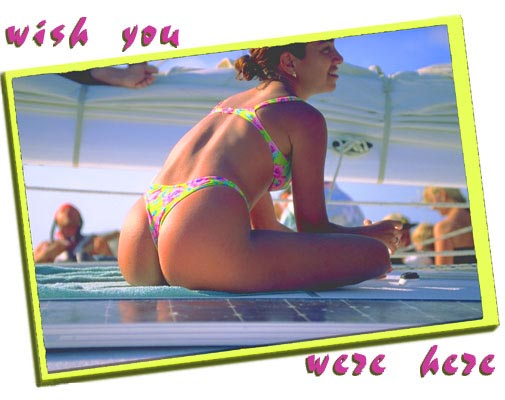
![]() Back on the boat we sailed to our second destination, where we were to
walk the beach. This stroll down the beach was to be our friendly contact
with the environment. The skipper prepared to nose the boat up to the soft
sand beach to allow us to disembark. I watched him attempt to maneuver
into the freshening breeze. I could tell by the way the wind and water
were running that what he was trying was not going to work. He called for
the anchor anyway. I was the first off the boat, but within minutes it was
obvious that the boat was too far aground. The skipper called me back
aboard and fired up the 75 hp Yamaha outboard engines in an attempt to
drag us back off the sand.
Back on the boat we sailed to our second destination, where we were to
walk the beach. This stroll down the beach was to be our friendly contact
with the environment. The skipper prepared to nose the boat up to the soft
sand beach to allow us to disembark. I watched him attempt to maneuver
into the freshening breeze. I could tell by the way the wind and water
were running that what he was trying was not going to work. He called for
the anchor anyway. I was the first off the boat, but within minutes it was
obvious that the boat was too far aground. The skipper called me back
aboard and fired up the 75 hp Yamaha outboard engines in an attempt to
drag us back off the sand.
![]() Being one
of the tourists disqualified me from making any suggestions the crew would
take seriously. Knowing this, however, made me even more determined to
have my say, as I knew if he proceeded to burn out the one good engine it
would be a long tack back to the airport. The skiff with its small
outboard came over from the second catamaran, the Tornado. He tied on and
pulled straight back. The skipper of the Hurakan ran his engine in
straight reverse. I convinced them, however, with lots of hand waving and
pointing, to pull in unison at an angle. With a pontoon catamaran, as with
a "pontoon" floatplane, it's always easier to get one pontoon
off at a time.
Being one
of the tourists disqualified me from making any suggestions the crew would
take seriously. Knowing this, however, made me even more determined to
have my say, as I knew if he proceeded to burn out the one good engine it
would be a long tack back to the airport. The skiff with its small
outboard came over from the second catamaran, the Tornado. He tied on and
pulled straight back. The skipper of the Hurakan ran his engine in
straight reverse. I convinced them, however, with lots of hand waving and
pointing, to pull in unison at an angle. With a pontoon catamaran, as with
a "pontoon" floatplane, it's always easier to get one pontoon
off at a time.
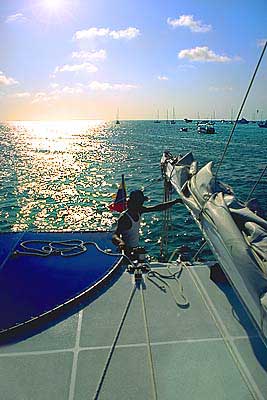
![]() Then with Gus' help we convinced the majority of the tourists to
disembark, thus lightening the load. Finally, although it seemed somewhat
futile for five or six men to be pushing such a large boat, I got them all
to push on the pontoon of choice. Within seconds the pontoon pulled free,
the boat cocked sideways, and then the second pontoon pulled free as well.
The Yamaha was saved and we were able to enjoy the rest of the days events
without worrying about leaving for home early.
Then with Gus' help we convinced the majority of the tourists to
disembark, thus lightening the load. Finally, although it seemed somewhat
futile for five or six men to be pushing such a large boat, I got them all
to push on the pontoon of choice. Within seconds the pontoon pulled free,
the boat cocked sideways, and then the second pontoon pulled free as well.
The Yamaha was saved and we were able to enjoy the rest of the days events
without worrying about leaving for home early.
![]() The skipper
re-anchored in a better location and we all went about our nature walk. In
fact the walk proved exciting for me. I had my bird binoculars, and was
able to positively identify two of my home town species. The brown
pelican, which was hard to miss, binoculars or no binoculars, and the
arctic tern. With the identification, came the realization that both these
species were preparing for the trip back north. It was late winter, early
spring in Canada, and soon they would start their migration back to their
breeding grounds. My backyard. As I had grown up reading about the birds
and their mysterious migrations, I had only observed one half of their
lives. Now I could see the other half.
The skipper
re-anchored in a better location and we all went about our nature walk. In
fact the walk proved exciting for me. I had my bird binoculars, and was
able to positively identify two of my home town species. The brown
pelican, which was hard to miss, binoculars or no binoculars, and the
arctic tern. With the identification, came the realization that both these
species were preparing for the trip back north. It was late winter, early
spring in Canada, and soon they would start their migration back to their
breeding grounds. My backyard. As I had grown up reading about the birds
and their mysterious migrations, I had only observed one half of their
lives. Now I could see the other half.
![]() I now knew
where they spent their winters. This archipelago is one of the few
remaining protected areas where either of these species can safely spend
part of their migration time, waiting to return north to their
reproductive cycle of life. Now it was dawning on me the importance of the
nature preserve. Not that I did not previously understand the
environmental reason for reserves, but that the reason had suddenly become
personal. Suddenly these were "my" birds. These brown pelicans
might nest along the river below the window of my house. They might be the
very ones that, each summer, foul the clean white diving board bolted to
my pile driven jetty.
I now knew
where they spent their winters. This archipelago is one of the few
remaining protected areas where either of these species can safely spend
part of their migration time, waiting to return north to their
reproductive cycle of life. Now it was dawning on me the importance of the
nature preserve. Not that I did not previously understand the
environmental reason for reserves, but that the reason had suddenly become
personal. Suddenly these were "my" birds. These brown pelicans
might nest along the river below the window of my house. They might be the
very ones that, each summer, foul the clean white diving board bolted to
my pile driven jetty.
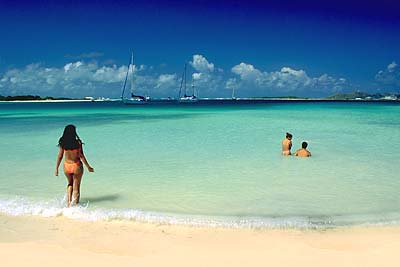
![]() And
the arctic terns are certainly the ones that I've seen skimming the cold
waters of the Arctic Ocean in northern Canada. Born in the arctic, they
have come from a long way off to fish these Venezuelan waters. Los Roque
is their home away from home. My birds' ultimate survival depends on the
good graces of these people living so far away. They depend on the
government to enact the legislation. The fishermen to cooperate with the
laws. The ecotourist operators to not abuse their right to bring in their
guests. And the tourists themselves to participate in the laws of the park
and help sustain the environment, not just for future visits, but for
"my" birds as well.
And
the arctic terns are certainly the ones that I've seen skimming the cold
waters of the Arctic Ocean in northern Canada. Born in the arctic, they
have come from a long way off to fish these Venezuelan waters. Los Roque
is their home away from home. My birds' ultimate survival depends on the
good graces of these people living so far away. They depend on the
government to enact the legislation. The fishermen to cooperate with the
laws. The ecotourist operators to not abuse their right to bring in their
guests. And the tourists themselves to participate in the laws of the park
and help sustain the environment, not just for future visits, but for
"my" birds as well.
![]() And while I
am contemplating all this warm and fuzzy connectivity, Anamaria is out
gathering garbage. Yes, the garbage is out there. Not from our boat mind
you. I had been watching. There are other tour operators in the area.
There are independent sail boats coming to anchor and enjoy the
tranquility. And there are the locals. The fishermen and their families,
who watch the tin cans rust and disappear over time. Who have no other
place to put their fish bones and old batteries, and who occasionally lose
the odd plimsole.
And while I
am contemplating all this warm and fuzzy connectivity, Anamaria is out
gathering garbage. Yes, the garbage is out there. Not from our boat mind
you. I had been watching. There are other tour operators in the area.
There are independent sail boats coming to anchor and enjoy the
tranquility. And there are the locals. The fishermen and their families,
who watch the tin cans rust and disappear over time. Who have no other
place to put their fish bones and old batteries, and who occasionally lose
the odd plimsole.
![]()
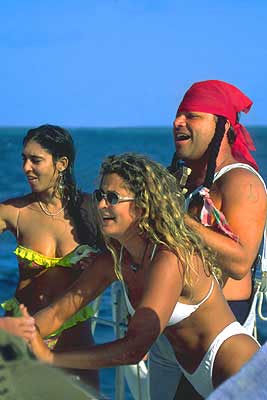
![]() They
are still all out there, making a living catching 90% of the lobsters
eaten in Caracas. Catching fish for the inns and hotels. Throwing their
cigarette packages over the side. But, there is still Anamaria, who has by
now filled her beach bag, and her pockets, and her hands, with pop cans
and plastic wrappers. She quietly carries the spoils back to the boat and
deposits it into the garbage container. Quietly she goes about her
business of getting the boat and passengers ready to continue the voyage.
This is not a conscience effort to impress anyone, but an effort because
she cares.
They
are still all out there, making a living catching 90% of the lobsters
eaten in Caracas. Catching fish for the inns and hotels. Throwing their
cigarette packages over the side. But, there is still Anamaria, who has by
now filled her beach bag, and her pockets, and her hands, with pop cans
and plastic wrappers. She quietly carries the spoils back to the boat and
deposits it into the garbage container. Quietly she goes about her
business of getting the boat and passengers ready to continue the voyage.
This is not a conscience effort to impress anyone, but an effort because
she cares.
![]() Gus now
dressed as Baby Huey, the largest baby in the world, comes out quietly. He
is all subdued and reflective compared to the previous caricatures of
jungle king and boisterous bustuous woman. He is the dependent baby. He is
my birds. With my lack of Spanish, and my short attention span, I never
heard a word Gus had said during his diatribes. After the Baby Huey act,
however, and after visiting the other tourists one by one, Gus came to me,
rubber nanny on a string, to explain. He sat down to talk environment to
me. He was serious. His message was that "I needed to know."
Gus now
dressed as Baby Huey, the largest baby in the world, comes out quietly. He
is all subdued and reflective compared to the previous caricatures of
jungle king and boisterous bustuous woman. He is the dependent baby. He is
my birds. With my lack of Spanish, and my short attention span, I never
heard a word Gus had said during his diatribes. After the Baby Huey act,
however, and after visiting the other tourists one by one, Gus came to me,
rubber nanny on a string, to explain. He sat down to talk environment to
me. He was serious. His message was that "I needed to know."
![]()
![]() I
will never know what Gus actually said on that boat trip. What I figured
out, however, was that Gus was a three act play. In the beginning, the
macho jungle king was the ruler of all he surveyed and he let everyone
know it through his boasts and challenges. Man means war. In the second
stage the boisterous woman, knew little more than the jungle king, with
her "body as weapon" mentality. But, she did represent a
softening toward the feminine side of the our culture. Sure women can be
whores, but more often they are mothers. They nurture our environment by
nurturing and raising the seeds of our sustenance and existence and
continuance. Women are the water and the warmth and the sunshine that we
all need to grow.
I
will never know what Gus actually said on that boat trip. What I figured
out, however, was that Gus was a three act play. In the beginning, the
macho jungle king was the ruler of all he surveyed and he let everyone
know it through his boasts and challenges. Man means war. In the second
stage the boisterous woman, knew little more than the jungle king, with
her "body as weapon" mentality. But, she did represent a
softening toward the feminine side of the our culture. Sure women can be
whores, but more often they are mothers. They nurture our environment by
nurturing and raising the seeds of our sustenance and existence and
continuance. Women are the water and the warmth and the sunshine that we
all need to grow.
![]() Finally,
act three. The big baby. The baby is growing and learning. The baby knows
little and is willing to learn. The baby is all of us, where we depend on
all others through the connectivity of culture and environment. We are all
orphans, but we are all family. Gus, the baby, is sitting down with me,
the map of Los Roque spread out before us, explaining that the graceful
flyer, with the corsair wings and sharp finned tails, is actually the
awkward and gaudy red-breasted frigate whose greatly exaggerated
dimorphism has made him the study of many a evolutionist. How did that
puffed out bright red chest get so damn big? Why did it get so big? Gus
knows.
Finally,
act three. The big baby. The baby is growing and learning. The baby knows
little and is willing to learn. The baby is all of us, where we depend on
all others through the connectivity of culture and environment. We are all
orphans, but we are all family. Gus, the baby, is sitting down with me,
the map of Los Roque spread out before us, explaining that the graceful
flyer, with the corsair wings and sharp finned tails, is actually the
awkward and gaudy red-breasted frigate whose greatly exaggerated
dimorphism has made him the study of many a evolutionist. How did that
puffed out bright red chest get so damn big? Why did it get so big? Gus
knows.
![]() Just in
case I did not get the big picture, Anamaria comes over to make sure I
understand the Los Roques course in Environment 101. I do now. Thanks to
them.
Just in
case I did not get the big picture, Anamaria comes over to make sure I
understand the Los Roques course in Environment 101. I do now. Thanks to
them.
Our flight back was on
the Canadian built Dash-7.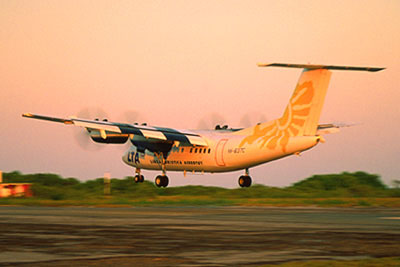
LTA also runs a scuba dive boat to the spectacular south reef, and provides scientific and naturalist tours from a 75 foot sleep aboard yacht for bird enthusiasts and for sea turtle environmental tours.
Article and Images by John S Goulet
![]()
Let the attitude indicator guide you back to Friends.
 Top of this
page.
Top of this
page.
Think Venezuela - the Tourism Directory
Last modified on
March 05, 2006 .
© Virtual Horizons, 1996.